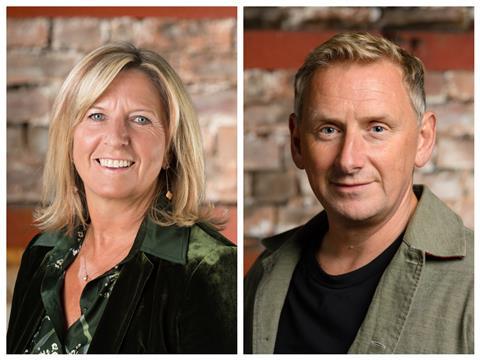ItŌĆÖs all change at the architecture practice as the firmŌĆÖs leadership makes way for the next generation. Karen Mosley and Richard OŌĆÖNeil talk about how to do an orderly succession, the crunch moment that led to it and the decision to walk away from two flawed MMC school projects

ŌĆ£Too often we hear in our profession of people sort of hanging on, not wanting to let go,ŌĆØ says Karen Mosley. ŌĆ£That stifles progress.ŌĆØ
The HLM managing director is talking to ║┌Č┤╔ńŪ° as she contemplates her own succession at the firm where she has worked for 36 years. This week, Mosley will step away from her role and stay on the board as a director, as will the firmŌĆÖs chair Richard OŌĆÖNeil. They will be replaced by two current directors, Michael Scherdel, who will be the managing director, and head of design Philip Watson, who will be the chair. Lorraine Robertson will also become the operations director.
It is the culmination of a decade-long transition plan aiming to draw a line under one era of the practice, which is celebrating its 60th anniversary this year, and to steer its future course.
Handing over the reins requires delicate management in any firm, but it seems the architecture profession can be particularly susceptible to fallouts. Just look at Adam Architecture founder Robert Adam, who . Avoiding such a public row takes careful handling and many practices will have experienced the lengthy discussions that go on behind the scenes at the top levels to ensure a smooth transition of power to the next generation.

ŌĆ£I think youŌĆÖve got to be able to stand back and say, actually, for the longevity of our business, for our brand and for innovation, we need to just see this as an evolutionary process,ŌĆØ Mosley says. ŌĆ£I think youŌĆÖve got to be prepared to see change, you know. ItŌĆÖs natural.ŌĆØ
It also requires an element of trust between the individuals involved, and a degree of expectation management for people who might be expecting promotion. Ensuring everyone knows where the firm is heading is almost like a ŌĆ£contractŌĆØ, according to OŌĆÖNeil. ŌĆ£YouŌĆÖre binding people together to take it all forward, and when you get that community culture, when you get that movement, thereŌĆÖs strength behind it.ŌĆØ
YouŌĆÖre binding people together to take it all forward, and when you get that community culture, when you get that movement, thereŌĆÖs strength behind it
Richard OŌĆÖNeil
HLM has been careful to build strong relationships as the succession plan has developed in order to hold the firm together and avoid the kind of strife seen in some other parts of the profession. For Mosley, speaking to ║┌Č┤╔ńŪ° on a quiet afternoon the week before the changes are made public, it is the end of an ŌĆ£incredible journeyŌĆØ.
ŌĆ£ItŌĆÖs half past five on a Friday night and itŌĆÖs feeling like weŌĆÖre sort of a week away from Richard and I reflecting on the journey that weŌĆÖve been on,ŌĆØ she says. ŌĆ£Not just as individuals, but as a practice, and the journey that weŌĆÖll continue to go on.ŌĆØ

HLMŌĆÖs journey
The moment has taken on greater significance for Mosley and OŌĆÖNeil because of the flurry of awards which the practice has amassed in the past few years, including being named practice of the year at the ║┌Č┤╔ńŪ° Awards in both 2022 and 2023. It has been a vindication for a process started back in 2014, when there had been a collective acknowledgement that the firm needed to reinvent itself after a challenging few years.
HLM specialises in UK public sector projects, which were squeezed in the wake of the 2008 financial crisis as funding for big schemes dried up. While order books had been filled up for a year or two by ongoing schemes, the firm realised that a crunch was approaching. ŌĆ£By 2009 we could see that it was going to be a major problem, there was the austerity aspect and they were going to turn the taps off,ŌĆØ OŌĆÖNeil says.
So the firm diversified by going international, securing work in the Middle East where it set up studios in Abu Dhabi and Dubai. This filled in gaps in the UK market which grew wider as the new David Cameron-led coalition government doubled down on its cost-cutting agenda.
By 2013 the firm was seeing green shoots coming back in its core UK business, but was also having to come to terms with a changing market. ŌĆ£I think the whole design process had moved on, and I think we were left behind a little bit,ŌĆØ OŌĆÖNeil says. ŌĆ£We just felt at that time, ŌĆśhang on, letŌĆÖs just do a big reset hereŌĆÖ. LetŌĆÖs think about what weŌĆÖve achieved so far after 50 years, but where are we going?ŌĆØ

ŌĆ£We were probably coming out of the back end of the recession,ŌĆØ Mosley adds, ŌĆ£and I suppose it was just recognition of where we are, where we want to be, and then thinking how weŌĆÖre going to get there and realising that we werenŌĆÖt the finished article, and that we needed to continuously learn about ourselves.ŌĆØ
It was recognition of where we want to be and realising that we werenŌĆÖt the finished article, and that we needed to continuously learn about ourselves
Karen Mosley
The practice hired an external consultant to carry out a 12 month programme aiming to ŌĆ£give the board an executive poke in the eyeŌĆØ, OŌĆÖNeil says. ŌĆ£It was a time to look in the mirror and really say ŌĆśwhat are we doing together here? WhatŌĆÖs our culture? LetŌĆÖs reset that. And we had some really positive, constructive conversationsŌĆØ.
Sustainability and the climate agenda was one area where the firm realised it needed investment, partly because of changing regulations but also out of a ŌĆ£consciousness to do the right thingŌĆØ.
The next shake-up began in 2017, when Mosley was appointed managing director and OŌĆÖNeil became chair, working closely with his predecessor and mentor Chris Liddle. Two years later it rebranded its design philosophy as ŌĆ£Thoughtful design to create better places for peopleŌĆØ, while focusing more towards offering staff a progressive and supportive workplace environment, becoming an employee ownership trust (EOT) in 2021. It also set a series of strategic objectives, namely gearing itself towards growing markets including net zero design and MMC.
HLMŌĆÖs recent experiences with MMC have not all gone as smoothly as it may have liked. Two modular school projects designed by the practice were ordered to be demolished at the end of last year because of structural defects. It was a story that made national headlines.
During construction, HLM had walked away from the schemes due to concerns it had with contractor Caledonian Modular, which later fell into administration in 2022. ŌĆ£It was a decision which nobody would take lightly, but we just felt we had no choice,ŌĆØ says OŌĆÖNeil.
The Department of Education later found the schools, the 1,200-place Haygrove School in Somerset and the 630-place Sir Frederick Gibberd College in Essex, had not been constructed as designed and could not be assured as safe to occupy.

While the incident was unfortunate for HLM, its bold decision to leave the projects has arguably strengthened its reputation in the eyes of public sector clients by demonstrating expertise and sound judgement.
ŌĆ£We have robust protocols to go through when we undertake projects. And if thereŌĆÖs any areas of conflict or aspects we need to identify and do due diligence, then we will probably be a bit more vocal about it. And you know, IŌĆÖm not sure what we could have done at the time over and above what we did do,ŌĆØ OŌĆÖNeil says.
>> See also: Government launches wider probe into Caledonian Modular after school closures
Has it affected how the firm now approaches projects of this kind? ŌĆ£It probably has shaped us a little bit,ŌĆØ OŌĆÖNeil says. ŌĆ£I think you always learn from these things. If you donŌĆÖt, then youŌĆÖve missed an opportunity.ŌĆØ
For Mosley, the experience is an example of how far the firm has come in recent years in defining its purpose and strengths, and how it has sought to set itself apart as a leader in the sector.
ŌĆ£Some businesses disappear, some brands disappear, some get consumed into other brands. I think weŌĆÖve got such a strong heritage and legacy, we wanted to see that live on, ad infinitum.ŌĆØ
Succession: HLMŌĆÖs new senior leadership team
Michael Scherdel ŌĆō managing director
ŌĆ£Being part of the HLM family for over 30 years and now taking up the post of MD speaks volumes of our ethos, how we trust in our team and that having a succession plan is essential. The HLM culture and brand remains strong and IŌĆÖm feeling excited about the future for our people, our clients and the spaces we create for societyŌĆØ.
Philip Watson - chair
ŌĆ£HLMŌĆÖs design profile and influence across industry has never been better than it is right now, but we wonŌĆÖt be resting on our laurels. Far from it. WeŌĆÖll be driving forward new plans to create an even more inclusive and nurturing workplace, focusing on achieving sustainable outcomes for our projects, and investing in research that will further enhance our reputation as innovative and thoughtful designers.ŌĆØ
Lorraine Robertson ŌĆō operations director
ŌĆ£The future is bright for HLM, and IŌĆÖm looking forward to taking on the role of Operations Director as part of this continuing journey, fostering the development of the next generation of design talent. People are at the centre of all of our work, from our EOT structure to the people experiencing our designs, and this is an integral aspect of HLM which will never changeŌĆØ



























No comments yet